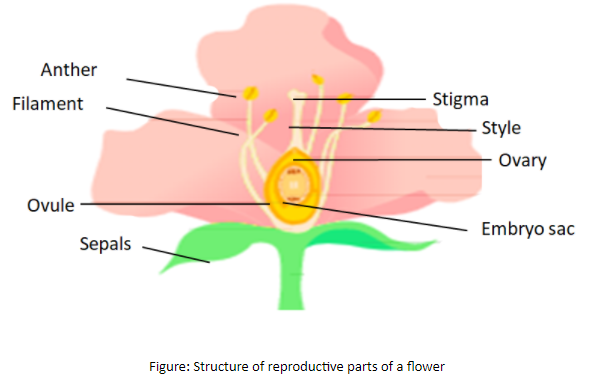
Name the reproductive part of the plant.
Answer
570.9k+ views
Hint: The flower is a reproductive organ in angiosperms, and it is the most remarkable feature that makes it unique from the other seed plants.
Complete answer:
A plant consists of stamen as the male reproductive part that produces pollen grains in stamens, while pistil/gynoecium is the female reproductive organ that includes stigma, style, and ovary. Flowering plants are the dominant plant on land that reproduces by sexual and asexual means. In flowering plants, sexual reproduction involves the production of male and female gametes.
Male reproductive part: The male part of the plant is known as stamens that are made up of the anther at the top and the filament, which supports the anther. The anther is a bilobed structure that consists of four microsporangia in each lobe. This microsporangium further develops into a pollen sac that finally produces the pollen grains.
Female reproductive organ: The female reproductive part of the plant is the pistil, which is generally located in the center part of the flower. Pistil contains three parts: stigma, style, and ovary. The stigma is present at the top of the pistil like a sticky knob and attached to the long, tube-like structure called the style. The style finally leads the ovary that comprises the female egg cells called ovules.
At the time of fertilization, pollen grains attach to the stigma on the top of a carpel. After this pollen grows down the style and sperm from pollen grain enters into the ovule to fertilize the egg cell. The fertilized ovule converts into the seed, and the ovary becomes the fruit.
Note: Double fertilization is a characteristic feature of flowering plants in which out of two sperm cells, one sperm fuses with the egg cell while another sperm fuses with two polar nuclei that resulted in a formation of diploid zygote and triploid primary endosperm nucleus (PEN), respectively.

Complete answer:
A plant consists of stamen as the male reproductive part that produces pollen grains in stamens, while pistil/gynoecium is the female reproductive organ that includes stigma, style, and ovary. Flowering plants are the dominant plant on land that reproduces by sexual and asexual means. In flowering plants, sexual reproduction involves the production of male and female gametes.
Male reproductive part: The male part of the plant is known as stamens that are made up of the anther at the top and the filament, which supports the anther. The anther is a bilobed structure that consists of four microsporangia in each lobe. This microsporangium further develops into a pollen sac that finally produces the pollen grains.
Female reproductive organ: The female reproductive part of the plant is the pistil, which is generally located in the center part of the flower. Pistil contains three parts: stigma, style, and ovary. The stigma is present at the top of the pistil like a sticky knob and attached to the long, tube-like structure called the style. The style finally leads the ovary that comprises the female egg cells called ovules.
At the time of fertilization, pollen grains attach to the stigma on the top of a carpel. After this pollen grows down the style and sperm from pollen grain enters into the ovule to fertilize the egg cell. The fertilized ovule converts into the seed, and the ovary becomes the fruit.
Note: Double fertilization is a characteristic feature of flowering plants in which out of two sperm cells, one sperm fuses with the egg cell while another sperm fuses with two polar nuclei that resulted in a formation of diploid zygote and triploid primary endosperm nucleus (PEN), respectively.

Recently Updated Pages
Master Class 11 Social Science: Engaging Questions & Answers for Success

Master Class 11 Physics: Engaging Questions & Answers for Success

Master Class 11 Maths: Engaging Questions & Answers for Success

Master Class 11 Economics: Engaging Questions & Answers for Success

Master Class 11 Computer Science: Engaging Questions & Answers for Success

Master Class 11 Chemistry: Engaging Questions & Answers for Success

Trending doubts
What is meant by exothermic and endothermic reactions class 11 chemistry CBSE

10 examples of friction in our daily life

Difference Between Prokaryotic Cells and Eukaryotic Cells

1 Quintal is equal to a 110 kg b 10 kg c 100kg d 1000 class 11 physics CBSE

One Metric ton is equal to kg A 10000 B 1000 C 100 class 11 physics CBSE

Draw a diagram of nephron and explain its structur class 11 biology CBSE




